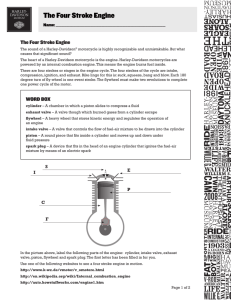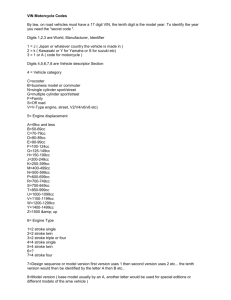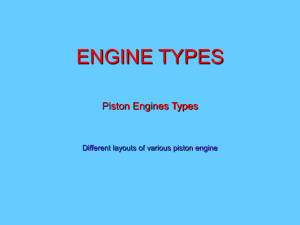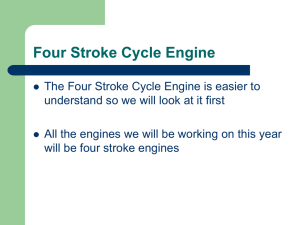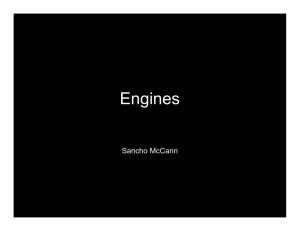THERMAL & IC ENGINE LAB MEP 1204 Page: 01/024 SEM
advertisement
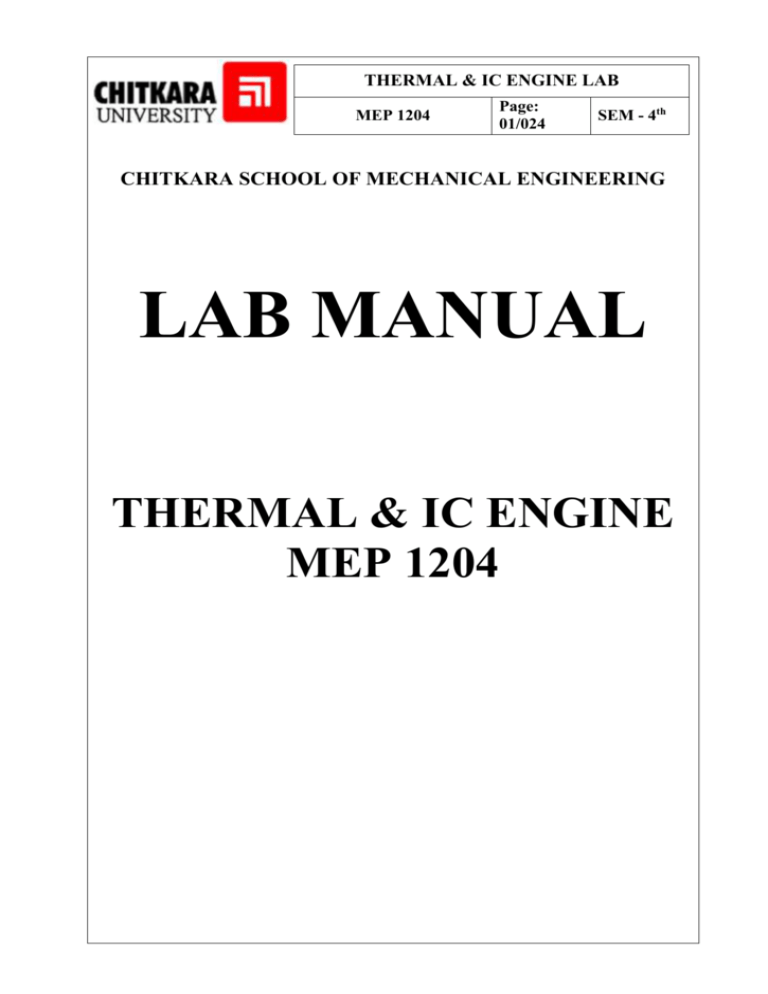
THERMAL & IC ENGINE LAB MEP 1204 Page: 01/024 SEM - 4th CHITKARA SCHOOL OF MECHANICAL ENGINEERING LAB MANUAL THERMAL & IC ENGINE MEP 1204 THERMAL & IC ENGINE LAB MEP 1204 Page: 02/024 SEM - 4th CHITKARA SCHOOL OF MECHANICAL ENGINEERING LIST OF EXPERIMENTS: 1. To Study 2 stroke and 4 stroke Petrol and Diesel engines. 2. To draw valve timing diagram of a petrol/diesel engine and study of its impact on the Performance of an IC Engine. 3. Study of principle of carburetion and a simple circuit of a carburetor fitted on Indian Make Vehicle. 4. Study of various types of Boiler models. 5. Determination of dryness fraction of steam through Separating and throttling Calorimeter. 6. Determine the brake power, indicated power, friction power and mechanical efficiency of a multi-cylinder petrol engine running at constant speed (Morse Test). 7. Performance of a diesel/ semi diesel engine for a single cylinder/ multi- cylinder engine in terms of brake power, indicated power, mechanical efficiency and SFC (Specific fuel consumption) and further obtain power consumption curves and draw the heat balance sheet. 8. Performance of single stage/ multi stage reciprocating compressor. 9. To determine the Performance characteristics of a typical Axial Fan test rig. 10. To determine the Performance characteristics of a Centrifugal Blower test rig. THERMAL & IC ENGINE LAB MEP 1204 Page: 03/024 SEM - 4th CHITKARA SCHOOL OF MECHANICAL ENGINEERING EXPERIMENT NO.1: To study 2 stroke and 4 stroke petrol and diesel engines. 2-STROKE AND 4-STROKE PETROL ENGINES CONSTRUCTION DETAILS: Cylinder: - It is a cylindrical vessel or space in which the piston makes a reciprocating motion. Piston: - It is a cylindrical component fitted into the cylinder forming the moving boundary of combustion system. It fits in cylinder perfectly. Combustion Chamber: - It is the space enclosed in the upper part of cylinder, by the cylinder head & the piston top during combustion process. Inlet Manifold: - The pipe which connects the intake system to the inlet valve of engine. Exhaust Manifold: - The pipe which connects the exhaust system to the exhaust valve of engine. Inlet / Exhaust Valves: - They are provided on the cylinder head to head to regulate the charge coming into or going out of the chamber. Spark Plug: - It is used to initiate the combustion process in S.I engines. Connected Rod - It connects piston & the crank shaft. Crank shaft: - It converts the reciprocating motion of the piston into useful rotary motion of output shaft. Gudgeon pins: - It forms a link between connection rod and the piston. Cam shaft: - It controls the opening & closing of the valves. Cam: - They open the valves at the correct tunes. Carburetor: - Used in S.I engine for atomizing & vaporizing and mixture it with air in varying proportion. THERMAL & IC ENGINE LAB MEP 1204 Page: 04/024 SEM - 4th CHITKARA SCHOOL OF MECHANICAL ENGINEERING BASIC ENGINE NOMENCLATURE Fig. shows the cross section of a spark ignited internal combustion engine. The cylinder is supported in position by the cylinder block. The nominal internal diameter of the cylinder is called bore. The top of the cylinder is covered by cylinder head. A piston reciprocates in the cylinder. The top position or the upper limit of the piston movement is called top dead center (TDC) and the bottom position or the lower limit is called bottom dead center (BDC). Piston movement between TDC and BDC is called stroke and the distance so covered is called stroke length and the corresponding volume displayed by the piston is called displacement or swept volume. The space enclosed between the cylinder head and the piston when it is at TDC position is called combustion chamber and its volume is called clearance volume. The ration of swept volume plus clearance volume to clearance volume is called compression ratio. The cylinder head has inlet and exhaust valves to induct and expel the engine charge. The engine charge when ignited by the spark plug expands and the energy so released is transmitted by the piston through the connecting rod to the crankshaft. One side of the connecting rod is connected to the piston by a piston or gudgeon pin and the other side to the crankshaft by a bearing and connecting rod cap. The crankshaft is supported in journal bearings attached to the crankcase, the main body of the engine. The crankshaft rotates a camshaft through timing gears. Cams or lobes on the THERMAL & IC ENGINE LAB MEP 1204 Page: 05/024 SEM - 4th CHITKARA SCHOOL OF MECHANICAL ENGINEERING camshaft causes the pushrods to move up which, in turn, move the rocker arm, thereby, opening the inlet and exhaust valves into inlet and exhaust manifolds. These valves are closed back by valve springs. 2-STROKE (S.I) ENGINES: In a 2-Stroke engine, the filling process is accompanied by the change compressed in a crank case or by a blower. The induction of compressed charge moves out the product of combustion through exhaust ports. Therefore, no piston stroke is required for these 2-strokes one for compression of fresh charge and second for power stroke. The charge conducted into the crank case through the spring loaded valve when the pressure in the crank case is reduced due to upward motion of piston during the compression stroke. After the compression & ignition expansion takes place in usual way. During the expansion stroke the charge in crankcase is compressed. Near the end of the expansion stroke, the piston uncovers the exhaust ports and the cylinder pressure drops to atmosphere pressure as combustion produced leave the cylinder. TWO STROKE PETROL ENGINE THERMAL & IC ENGINE LAB MEP 1204 Page: 06/024 SEM - 4th CHITKARA SCHOOL OF MECHANICAL ENGINEERING 4-STROKE (S.I) ENGINES The actions in the cylinder can be divided into four parts or strokes called the induction stroke, the compression stroke, the power stroke, and the exhaust stroke; the four strokes making up the complete cycle of events in the cylinder. In a four stroke cycle engine the cycle of actions in the cylinder is completed in four strokes of the piston, i.e. two revolutions of the crankshaft, each stroke consisting of 180 degrees of crankshaft rotation. The sequences of operation in an ideal four stroke spark ignition engine cycle are given as: FOUR STROKE PETROL ENGINE THERMAL & IC ENGINE LAB MEP 1204 Page: 07/024 SEM - 4th CHITKARA SCHOOL OF MECHANICAL ENGINEERING Induction Stroke- The piston moving from TDC to BDC draws a mixture of fuel and air through open inlet valves and fills the cylinder. This is possible because the atmospheric pressure pushes air through the carburetor and into the cylinder where a vacuum has been created due to piston movement. Compression Stroke- Rising piston compresses the charge against closed inlet and exhaust valves, spark plug fires, starting the combustion. Expansion or Power Stroke- Burning mixture expands, forcing the piston down. Both inlet and outlet valves remain closed. This is the one stroke of the four strokes that delivers power. Exhaust Stroke- The rising piston forces products of combustion out of the cylinder through the open exhaust valves. DISCUSSION: S. NO. TWO STROKE ENGINES 1. In each round there is power stroke. In every two rounds there is power stroke. 2. The engine cycle is completed in one round of the crank shaft i.e. two stroke. For inlet and exhaust, port are provided. Lubrication is done by mixing oil in the petrol The engine gets cool by air itself. 3. 4. 5. 6. 7. 8. FOUR STROKE ENGINES The engine cycle is completed in two rounds of the crank shaft i.e. four stroke. Valves are used for inlet and exhaust. Separate arrangement has to be done for the lubrication. These are generally cooled by water. It is necessary to make the crank Ventilation is provided in the crank case air-tight. case. Less Horse power is obtained. More Horse power is obtained. 9. These engines are used for light These are used for heavy job. jobs. Their thermal efficiency is low. Their thermal efficiency is high. 10. These move in one direction only. These engines can be driven in both the directions. THERMAL & IC ENGINE LAB MEP 1204 Page: 08/024 SEM - 4th CHITKARA SCHOOL OF MECHANICAL ENGINEERING STUDY OF TWO STROKE AND FOUR STROKE DIESEL ENGINES. CONSTRUCTION DETAILS: Cylinder: - In it the piston makes a reciprocating process motion. Piston: - It is a cylindrical component fitted into the cylinder forming the moving boundary of the combustion system. It fits into cylinder. Combustion Chamber: - The space enclosed in the upper part of the cylinder, by the head and the piston top during the combustion process. Inlet/ Outlet ports: - They are provided on the side of cylinder to regulate the charge coming in and out of cylinder. Fuel Injector: - It injects the fuel in combustion chamber to initiate combustion process for power stroke. Connecting Rod: - It interconnects crank shaft and the piston. Fly Wheel: - The net torque imparted to the crankshaft during one complete cycle of operation of the engine Fluctuates during change in angular velocity of shaft. In order to achiever uniform torque an internal mass is attached to the output shaft & this is called as fly wheel. TWO STROKE (C.I.) ENGINE In two stroke engines, the cycle is completed in one revolution of the crankshaft. In 2-stroke engine, the filling process is accomplished by the charge compressed in crankcase or by a blower. The induction of compressed charge moves out of the exhaust ports. Therefore, no piston strokes are required for these 2 operations. Two strokes are sufficient to complete the cycle one for compressing the fresh charge and other for expansion or power stroke. Compression: The air or charge is inducted into the crankcase through the spring loaded inlet valve when the pressure in crankcase reduced due to upward motion of piston. Expansion: During this, the charge in the crankcase is compressed. At the end the piston uncovers the exhaust ports and cylinder pressure drops to the atmospheric pressure. Further movement of piston opens the transfer ports, permitting the slightest compressed charge in the crankcase to enter the engine cylinder. THERMAL & IC ENGINE LAB MEP 1204 Page: 09/024 SEM - 4th CHITKARA SCHOOL OF MECHANICAL ENGINEERING TWO STROKE DIESEL ENGINE Four Stroke Cycle Compression Ignition Engine (Diesel) The four stroke compression ignition is similar to a S.I. Engine except that a high compression ratio is used in the former and during the suction stroke and alone instead of a fuel- air mixture is inducted. The high temperature attained at the end of compression is sufficient to ignite the fuel injected into the combustion chamber. Instead of a carburetor and ignition system a high pressure fuel pump and injector are used to inject the fuel into combustion chamber. The sequence of operation in an ideal four-stroke compression ignition engine cycle is as follows: Induction Stroke- The piston moving from TDC to BDC draws air alone through open inlet valves. Compression Stroke- Rising piston compresses the air against closed inlet and exhaust valves. Expansion Stroke- The fuel is injected in the beginning of the stroke. It ignites expands and forces the piston down, both the valve remaining closed. Exhaust Stroke- The rising piston forces products of combustion out of the cylinder through open exhaust valves. THERMAL & IC ENGINE LAB MEP 1204 Page: 010/024 SEM - 4th CHITKARA SCHOOL OF MECHANICAL ENGINEERING DISCUSSION: S. No 1. 2. 3. 4. 5. 6. 7. 8. 9. 10. PETROL ENGINES In suction stroke mixture of air and petrol comes into cylinder. Compression ratio ranges from 4 : 1 to 10 : 1. High tension current is used to ignite the mixture. Spark plug is used. Fuel pump is used only to lift the petrol. As the starting torque is less, small battery can be used. For one Horse power more petrol is required which is costly. These are light engines and these cannot be made more powerful. These engines are cheap. These engines work on the principle of Auto-cycle. DIESEL ENGINES In suction stroke only clean air enter the cylinder. Compression ratio ranges from 11 : 1 to 20 : 1. For igniting diesel compressed hot air is used. Injector is used. Without the fuel injection pump engine cannot be operated. As the starting torque is more, use of large battery is must. Less quantity of diesel is required for an Horse power and diesel is cheaper. This is a heavy engines and these can be made highly powerful. These engines are costly. These engines work on the principle of Diesel cycle. THERMAL & IC ENGINE LAB MEP 1204 Page: 011/024 SEM - 4th CHITKARA SCHOOL OF MECHANICAL ENGINEERING Experiment No 2: To draw valve timing diagram of a petrol/diesel engine and study of its impact on the performance of an IC engine. Valve timing diagram for 4 stroke system Theoretically it may be assumed that the valves open and close and the spark (or injection of fuel) occurs at the engine dead centers. However, in actual operation, the valves do not operate at dead center positions but operate some degree on either side of the dead centers. The opening occurs earlier and the exhaust continues even at later crank angles. The ignition is also timed to occur in advance of the completion of compression stroke. The timing of these events, referred in terms of crank angles from dead center positions, is represented on a valve timing diagram. The correct timings are of fundamental importance for the efficient and successful running of the I.C. engine. 1. Inlet valve: Due to inertia effect and the time required in attaining full opening, the inlet valve is made to open somewhat earlier than TDC so that by the time the piston reaches TDC, the valve is fully open. For an engine running at low speed and with throttle opening, there is vacuum in the cylinder throughout the intake strike and on the completion of the strike the cylinder is almost filled with charge at atmospheric pressure. However, majority of I.C. engines run at tremendous speeds. Consequently during suction stroke the piston will reach the BDC Before the charge could get enough time to enter the cylinder through the inlet valve passages. Moreover, there is considerable resistance to the flow of charge through the air cleaner. Inlet and ports. This means that if the inlet valve is closed at BDC the cylinder by each cycle would receive charge less than its capacity and the pressure inside the cylinder would remain somewhat less than the atmosphere. THERMAL & IC ENGINE LAB MEP 1204 Page: 012/024 SEM - 4th CHITKARA SCHOOL OF MECHANICAL ENGINEERING Consequently, in actual operation, inlet valve is kept open the cylinder pressure equals the atmospheric pressure. It may app. The inlet valve is open even during compression, some of the charge may be sent back to the induction pipe. On the contrary, the kinetic energy of the air fuel mixture (or air) produces the ramming effect which enables more charge to enter the cylinder. Theoretically it may be possible to induce charge more than volume capacity of the combustion space. The greater charge sucked in by opening the inlet valve before TDC. and closing it 40-450 after BDC increases the potential output of the engine. 2. Ignition (or injection): The TDC would be proper time to produce spark if the charge could burn instantaneously. However, there is lag between the timing of spark and that of actual ignition. For best result with regard to power and economy, and to avoid explosion knock, the ignition of charge is timed to occur as early as the engine permits. At higher speeds the ignition timing is called ignition advance. With too early ignition, the complete ignition may occur before the piston reaches the TDC and this may cause back explosion. The back explosion will cause the engine to run in the reversed direction of rotation. In diesel engines, too, there is a brief interval of time for the fuel oil to mix with the hot compressed air in the cylinder and ignite. The injection of fuel is timed to occur about 10-150C before TDC. so that by the time the piston reaches TDC the actual combustion of fuel starts. 3. Exhaust valve: The scavenging period (period available for discharge of burnt gases) is increased by opening the exhaust valve in advance i.e. before BDC. and closing it with delay, i.e. after TDC Earlier opening makes it possible for the exhaust gases to leave by virtue of their pressure being higher than the atmosphere. During late closure, the kinetic energy of fresh charge is utilized to assist in the maximum exhausting cylinder. Thus scavenging is being obtained is being obtained at the cost of power from the expansion stroke. All the same a greater portion of the burnt gases is exhausted and this reduces the among of the work to be done by the piston on the return stroke. The Valve timing diagrams for four -stroke petrol engine and diesel engine are shown in Figure. The values of the angular positions quoted are only average one and considerable difference exists with different engines. Further the timings area function of the engine speed. When the engine is to run faster, the inlet valve is made to close. The exhaust valve opens earlier and the ignition (injection) is Occur earlier. It may be seen that for some part of the cycle near TDC both the valves are open and this period is called overlap. THERMAL & IC ENGINE LAB MEP 1204 Page: 013/024 SEM - 4th CHITKARA SCHOOL OF MECHANICAL ENGINEERING Valve Timing Diagram for Diesel Engines The valve timing diagram for actual engine is shown in fig. For a typical diesel engine. The various strokes are modified for similar reasons as explained in case of petrol engine. THERMAL & IC ENGINE LAB MEP 1204 Page: 014/024 SEM - 4th CHITKARA SCHOOL OF MECHANICAL ENGINEERING EXPERIMENT No: 3:STUDY OF VARIOUS CIRCUITS OF A CARBURETOR FITTED ON INDIAN MAKE VEHICLE Carburetor: A carburetor is a mechanical device used in S.I. Engines to fulfill the following requirements: (i) To meter the liquid fuel in such quantities as to produce a specified air-fuel ratio required to meet engine operating conditions (i.e. various loads and speeds). (ii) To atomise and vaporize the fuel and mix it homogeneously with the air. Simple Carburetor: In S.I. engines, the primary element of a fuel system consists of a storage tank, fuel pump, carburetor and manifold. SIMPLE CARBURETOR THERMAL & IC ENGINE LAB MEP 1204 Page: 015/024 SEM - 4th CHITKARA SCHOOL OF MECHANICAL ENGINEERING SOLEX CARBURETOR 1 - Retaining screw 2 - Passage where high speed mixture enters air stream 3 - Needle & seat (after market shown, original has a spring loaded ball end) 4 - Fuel inlet banjo bolt (hollow bolt) 5 - Cover 7 - Injection nozzle 8 - Body 9 - Idle jet THERMAL & IC ENGINE LAB MEP 1204 Page: 016/024 SEM - 4th CHITKARA SCHOOL OF MECHANICAL ENGINEERING 10 - Float level adjustment screw & lock nut 11 - Accelerator pump level 12 - Accelerator pump quantity adjustment nut & lock nut 13 - Accelerator actuation lever 14 - Accelerator pump control rod 15 - Main jet carrier (main jet screws into inner end) 16 - Mixture screw adjustment 17 - Idle stop screw & spring 18 - Throttle shaft 19/20 - Throttle lever 21 - Pump jet 22 - Diffuser (aux venturi) 23 - Air correction jet (a) Float Chamber: The function of a float chamber is to maintain a constant level of fuel in the carburetor unit. This is achieved by a float which controls a needle valve placed in a fuel supply line. The fuel is pumped into the float chamber by means of a fuel pump if the amount of fuel in the float chamber falls below the designed value, the float lowers, thereby the needle valve (fuel supply valve) opens and the fuel enters the float chamber at a greater rate than the engine requires. When the designed level has been reached, the float rises up and closes the needle valve, thus stopping additional fuel flow from the supply system. By this way a constant level of fuel in maintained in the float chamber. A vent is provided in the float chamber which communicates the fuel in the chamber with atmosphere pressure. A filter is provided in the fuel supply system, so that, no foreign particles should clog the needle valve. (b) Venturi: Air from the atmosphere is drawn through the venturi by the action of the piston on the intake stroke. As the air passes through the venture, its velocity is increased at the throat (due to small area and constant mass flow rate) with a corresponding reduction in pressure. Thus a partial vacuum is created at the throat called the carburetor depression. Since the float chamber is vented to atmosphere, a pressure differential exists between the float chamber and the tip of fuel discharge nozzle. This pressure differential causes the fuel to discharge (spray) into the air stream in an amount depending upon the magnitude of this pressure differential. The fuel thus sucked in vaporized by the coming air stream. The vaporization of fuel depends upon the pressure at the venturi, temperature and velocity of air and nature of the fuel. (c) Throttle: The function the throttle is to control the quantity of air fuel mixture supplied to the engine cylinder, and thus, by this way, control the speed and power of the engine. It serves as a damper placed between the chamber and induction manifold. The control of the throttle valve is normally with the accelerator pedal through certain linkage. The more the throttle is closed the greater will be the obstacle to flow of mixture delivered to the cylinder and hence the engineer power and speed will reduce till an equilibrium is reached. When the throttle valve is fully open, the engine will suck the maximum amount of mixture and the engine speed will go up till equilibrium is reached between the engine power and the load on the engine. THERMAL & IC ENGINE LAB MEP 1204 Page: 017/024 SEM - 4th CHITKARA SCHOOL OF MECHANICAL ENGINEERING (d) Choke: The function of choke is to provide an extra rich mixture during starting and warm up in cold weather to ensure that enough fuel is available in vaporized from, for combustion. The choke valve is placed in the air intake system on the upstream side of the venturi. When the choke valve is nearly closed (engine choked), a vacuum is created in the area found the fuel discharge nozzle. The pressure differential between the float chamber and the venturi area forces additional fuel in the air stream. Elements of a completed Carburetor: In order to overcome the drawbacks of simple carburetor, it is essential to provide the following systems in the simple carburetor to satisfy the demands of an engine under all conditions of operation. (a) Main metering system. (b) Idling system. (c) Power enrichment system. (d) Acceleration pump system. THERMAL & IC ENGINE LAB MEP 1204 Page: 018/024 SEM - 4th CHITKARA SCHOOL OF MECHANICAL ENGINEERING Experiment no.4: Study of various types of boilers, boiler trial estimation of equivalent evaporation and efficiency of fire tube/water tube boiler. Cochran Boiler- The Cochran boiler is one of the most popular and best type of vertical, multi tabular fire tube (internally fired) natural circulation boiler. COCHRAN BOILER THERMAL & IC ENGINE LAB MEP 1204 Page: 019/024 SEM - 4th CHITKARA SCHOOL OF MECHANICAL ENGINEERING Construction Details: Fig. shows the Cochran boiler. It consists of a vertical cylindrical shell having a hemispherical top. The shell is mild steel plates. The furnace is also hemispherical in shape and it is hydraulically pressed from one plate without a single weld or scam. Thus the furnace is strongest structure under compression. As there are no scams in the furnace, the source of furnace trouble is removed in this boiler. The fire grate is arranged in the furnace and the ashpit is provided below the grate. In the firebox, a fire door and a damper are provided. Adjacent to the firebox, the boiler has a combustion chamber, which is dry backed and lined with firebricks. Close to the combustion chamber a number, of horizontal smoke tubes are provided. These tubes are of equal length and arranged in a group with wide space in between them and the shell so as to help convection currents. The ends of these smoke tubes are fitted in the smoke ---- tube plate and combustion chamber tube plates. These tubes are simply pushed in the holes of tube plates and then expanded at the ends to make steam light joints. The smoke box is built of steel plates and is fitted with hinged door, which gives an easy access to smoke tubes for cleaning and inspecting. The stack is provided at the top of the smoke box for discharge of the gases to the atmosphere. The furnace is surrounded by water on all sides expect at the opening for the fire door and the combustion chamber. The smoke tubes are also completely surrounded by water. Different boiler mountings and accessories are located at their proper place. Working – The hot gases produced form the burning of the fuel on the grate rise up through the flue pipe and reach the combustion chamber. The flue gases from the combustion pass through the fire tubes and the fire tubes and the smoke box and finally are discharged through the chimney. The flue gases during third level from the firebox to the chimney give heat to the surrounding water to generate steam. The circulation of water in the shell is shown by arrows. The water courses down by the cooler wall of the shell and rises up past the fire tubes by natural circulation due to convention current. Babcock Wilcox Water Tube Boiler- It is a longitudinal drum, externally fired, water tube, natural circulation type of stationary boiler. Since the boiler is externally fired it is suitable to all types of fuels and for hand stroke firing. THERMAL & IC ENGINE LAB MEP 1204 Page: 020/024 SEM - 4th CHITKARA SCHOOL OF MECHANICAL ENGINEERING BABCOCK WILCOX WATER TUBE BOILER Construction figure shows the details of a Babcock Wilcox water tube boiler. It consists of a high pressure drum mounted at the top. The drum of the boiler made of welding steel or single course joined by longitudinal but strap. The head of the drum are forged by hydraulic press and are dished to a radius equal to the diameter of the drum. From each end of the drum connections are made with the upper header and down take header. A large number of water tubes connects the uptake and down take headers. The water tubes are inclined 5 to 15 degrees to promote water circulation. The water tubes are straight, solid drawn steel tubes about 10cm in diameter and are expanded into the bored holes of the headers to ensure proper fixing. The headers have a serpentine (sinusoidal) form. The serpentine form of heads arranges the water tubes such that they are staggered and this exposes the complete heating surface to flue gases. The heating surface of the unit is the outer surface of the tubes and half of the cylindrical surface of the water drum which is exposed to flue gases. THERMAL & IC ENGINE LAB MEP 1204 Page: 021/024 SEM - 4th CHITKARA SCHOOL OF MECHANICAL ENGINEERING A mud box is attached to the bottom of the rear header (i.e. down take header). Any foreign matter held in suspension in the water gets collected in the mud box due to gravity and it can be blown off from time to time. A hand hole is also provided for cleaning the mud box. To clean the outside of the water tubes and to remove the sot, a door is provided so that access to the interior of boiler can be made. The whole of the assembly of water tubes is hung along with the drum from a steel girder frame by steel rods called slings in a room made of masonry work, lined with fire bricks. The sling passes around each of the drum and is thus entirely independent of the brickwork of the setting. The boiler can expand or contract freely without straining the brickwork setting. Below the uptake header the furnace of the boiler is arranged. The coal is fed to the chain grate stroke through the fire door. The chain speed is so adjusted that by the time the coal reaches the other end of the grate, its combustion has been complete. There is bridge wall deflector, which deflects the combustion gases upwards. Baffles are arranged across the water tubes to act as deflector for the flue gases and to provide them with gas passes. Here two baffles are arranged which provide three passes of the flue gases. A chimney is provided for the exit of the gases. A damper is placed at the inlet of the chimney to regulate the draught. There are superheating tubes for producing super head steam. Connections are provided for other mountings and accessories. Working – The hot combustion gases caused by burning of fuel on the grate rise and are deflected upwards by the bridge wall deflector and pass over to the front portion of the tubes and drum. By this way they complete the first pass. With the provision of baffles they deflect downwards and complete the second pass. Again, with the provision of baffles they rise upwards and complete the third pass and finally, come out through the chimney. The flow path of the combustion gases is shown by the arrows outside the tubes. During their travel they give heat to water and steam is formed. The circulation of water in the boiler is natural circulation set up by convective currents. Feed water is supplied by a feed water inlet pipe. The hottest water and steam rise from the tubes to the uptake header and then through the rise enters the boiler drum. The steam vapors escape through the water to the upper half of the drum. The cold water from the drum to the rear header and thus the cycle is completed. The down comers are located outside the furnace to enhance circulation. To get superheated steam, the steam accumulated in the steam space is allowed to enter into the super heater tubes which are placed above the water tubes. The flue gases passing over the flue tubes produce superheated steam. The steam thus superheated in finally supplied to the user through a steam and stop valve. It is to be noted that when the steam has to be raised from the cold boiler, the super-heater tubes are filled with water to the drum water level. The super heaters remain flooded until the steam reaches the working pressure. The super heater is then drained and steam is allowed to enter in it for super heating purposes. THERMAL & IC ENGINE LAB MEP 1204 Page: 022/024 SEM - 4th CHITKARA SCHOOL OF MECHANICAL ENGINEERING Experiment 5: Determination of dryness fraction of steam through Separating and throttling Calorimeter. Separating and throttling Calorimeter: The set up consists of a separating and throttling calorimeter. An electric boiler provided at the base of the apparatus generates steam. The steam from the boiler is passed through the separating calorimeter, where most of the water particles are separated from the steam; it is then passed through the throttling calorimeter where the steam gets superheated. After that the superheated steam is passed through a heat exchanger where it is condensed. SEPARATING AND THROTTLING CALORIMETER THERMAL & IC ENGINE LAB MEP 1204 Page: 023/024 SEM - 4th CHITKARA SCHOOL OF MECHANICAL ENGINEERING Procedure: • Switch the main supply to the heaters of the steam generator and set the thermostat knob at 120°. • Fully open the ball valve when the pressure of steam generator rises to 2 Kgf/cm² • Open the water supply to the heat exchanger. • Slowly open the needle valve after the separating calorimeter and maintain a constant pressure as indicated by the pressure gauge before the throttling calorimeter. • A buzzing sound comes from the throttling calorimeter, which indicates throttling. • Allow some time for steady state to be reached. • Note the pressure difference and temperature and throttling from the manometer and barometer. • Collect the condensed moisture from the separating calorimeter and weight it. • Also collect the dry steam condensed after the throttling calorimeter and weight it. • Calculate the dryness fraction of steam. THERMAL & IC ENGINE LAB MEP 1204 Page: 024/024 SEM - 4th CHITKARA SCHOOL OF MECHANICAL ENGINEERING Precautions: 1. Make sure that the cold water supply to the heat exchanger is on before opening the steam valve. 2. Do not set the value of the thermostat knob above 120° 3. Manometer should be half filled with water.

